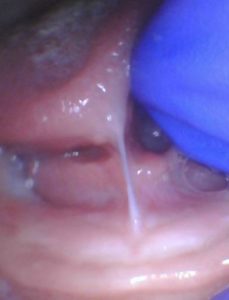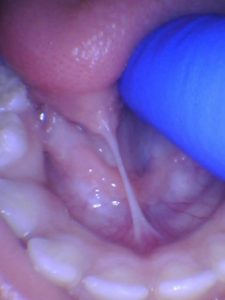It seems that everywhere you read online, a tongue-tie seems to be one of the first issues suggested when babies can’t eat or kids can’t speak well. Let’s go through some easy ways that parents can tell if their baby or child might be affected by this condition.
1. The Obvious

If your child has a heart-shaped tongue, a short tongue, can’t lift or stick out their tongue, there might be a problem. Sticking the tongue out is not a great test. Instead, ask your child to lift their tongue (or do it for them). If you can see an obvious string attaching near the top of the tongue, then there is very likely a restriction present that could be affecting your child. Go on to point #3.

2. The Not-So-Obvious
Many times a parent will think their child has some or all of the symptoms of a tongue-tie, but when they lift the tongue the string (frenum) isn’t attached to the tip or even near it. It’s 50% of the way back, or maybe even 25% visible or there might be no appearance of a frenum at all. A posterior tongue tie is a term that describes a less obvious variant of tongue restriction that is more common than the classic to-the-tip variety but is less easy to identify. Healthcare providers have not been taught about its existence in medical or dental school, or in continuing education courses.
The posterior tie is most easily identified by coming from behind the patient and lifting the tongue with both index fingers on either side of the tongue. The fascia or connective tissue bunches up and forms the appearance of a string or frenum, and often there is a good bit of tension as well. But the presence of this appearance alone does not mean the baby or child has a tie. They must be having symptoms in addition to the tight string of tissue in order to qualify as a tongue-tie.

You gotta lift it up to see it!

Notice the restrictive lip-tie and not obvious (at first) tongue-tie, until tension is applied.
3. The Symptoms
Regardless of the appearance under the tongue, it’s the symptoms that count. No symptoms, no treatment. If it ain’t broke, don’t fix it! Common infant and child symptoms are listed below. Contrary to popular opinion, none of these symptoms are required or the absence of a symptom doesn’t rule out a tongue-tie. Sometimes a tongue-tied infant has poor weight gain, other times they can be chunky and the mother is compensating for the inefficient feeding, or has a large milk supply. Sometimes nursing hurts worse than labor, other times there is moderate pain, and sometimes there is zero pain from a tongue-tied baby. (And very often, the painful latch happens in babies with a not-so-obvious posterior tongue-tie.)
Some kids with a tongue-tie have perfect speech, others have a significant speech delay or speech issues with mumbling, clarity, sounds (R, L, S, etc.) and confidence. Same with feeding (slow and picky eating, especially with meat), and with sleep (restless sleep, snoring, teeth grinding, etc.). So it’s the overall picture of the child’s limitations that are important. Look at all of the issues together, or check off a form like ours, the Infant Assessment Sheet or the Child Assessment Sheet. If you have more than a few checkmarks on there, there is likely a problem.
Infant’s Issues
- Poor latch
- Poor weight gain
- Reflux or spitting up often
- Clicking or smacking noises
- Gassy or fussy often
- Milk leaking out of the mouth
- Frustration with eating
- Prolonged nursing or feeding sessions
- Constantly hungry
Mother’s Issues
- Painful nursing
- Creased, flattened, blanched nipples
- Blistered or cut nipples
- Poor breast Drainage
- Plugged ducts or mastitis
- Nipple shield required for nursing
Child’s Issues
- Frustration with communication
- Trouble with speech sounds, hard to understand, mumbling
- Speech delay
- Slow eater
- Picky eater, especially with textures (meat, mashed potatoes)
- Choking or gagging on liquids or foods
- Spitting out food or packing food in cheeks
- Restless sleep (kicking or moving while asleep)
- Grinds teeth at night
- Sleeps with mouth open
- Snores (quiet or loud)
- Frequent headaches or neck pain
4. Trust Your Mother’s Instinct
Sometimes you have to go with your gut. If you think something is “off” with your child, 99% of the time, something IS wrong. Even in the face of professionals telling you “it’s fine we see this sometimes,” or “all babies are fussy, gassy, colicky, etc.,” or “his siblings talk for him,” trust your instincts. It’s common for babies to be gassy and fussy, and not eat well, because frankly, tongue-ties ARE common (25% at our best current estimates). Because these symptoms are so common, they are confused for being normal.
Dental cavities are common, but not normal. If a baby is spitting up all the time, “toots” like a grown man, and milk leaks out everywhere when eating, those are common symptoms, but not normal symptoms. There is very likely a physical reason to explain those. And very often, it’s a lip or tongue-tie.
So What Should You Do About It?
It’s helpful to see a lactation consultant or feeding therapist if you are concerned with your infant or child’s feeding, but make sure they have contemporary knowledge of tongue or lip ties. Ask if they have taken a course recently because it’s not taught in schools yet (even though it’s been around since Biblical times).
It’s also helpful to rule out other issues, so see the speech therapist, or a myofunctional therapist, and initiate therapy. But if the tongue-tie is obvious, no amount of therapy will correct a structural problem. If it is less obvious, then maybe therapy can help the issue, but if you hit a wall, or your child has symptoms in multiple domains (speech and feeding and sleep) then have the tongue-tie treated as part of a comprehensive therapy plan, working alongside your therapist’s recommendations.
That’s why it’s so critical to find a therapist who has gone out of their way to gain knowledge (or here, or here, or here, lots of options for education!) in this emerging field of tongue and lip-ties, or tethered oral tissues (TOTs). At the same time, we have seen children who have been in therapy for years, or even over a decade, that had a significant to-the-tip or close to the tip tongue-tie! The dentist, pediatrician, therapist, no one even mentioned it to the parent.
Make sure you have your child evaluated by a knowledgable provider, who has taken additional CE courses, attended recent conferences on tongue-ties, treats them routinely (several a week at least), and assesses for all the symptoms and possible presentations (anterior and posterior tongue-tie). It’s a spectrum of restriction, and some are obvious, other tongue restrictions are barely visible. Ensure they recommend stretches and exercises in addition to treatment, and ask what method they use to release.
Educate yourself on the effects a tongue restriction can have on an infant, child, or adult, and spread the word. We have some additional information on our webpage, The Facts.
We’re trying to spread the word with our recent book, Tongue-Tied: How a Tiny String Under the Tongue Impacts Nursing, Speech, Feeding, and More (download PDF sample here) as well as our latest article published in Clinical Pediatrics on the functional improvements after a proper tongue-tie release.
In our study (download the PDF here!), 89% of the children had improved speech after the procedure, 83% had better feeding, and 83% had better sleep. So it’s not every child has improvements in every area, but many do. When combined with therapy, those numbers are even better.
If you are a parent and concerned your child might have a tongue-tie, we’d be happy to chat with you or schedule a consultation. Just call us at 205-419-4333 or send us a message.
If you are a provider and have any questions about this post, or want to learn more, check out our recent course, Tongue-Tied Academy designed to help providers learn the procedure and Tongue-Tied Academy LITE for therapists who want to learn more. There is even a free preview of the course available. You can use the coupon code BLOG to save $250 off the full version or save $50 off the LITE version.




